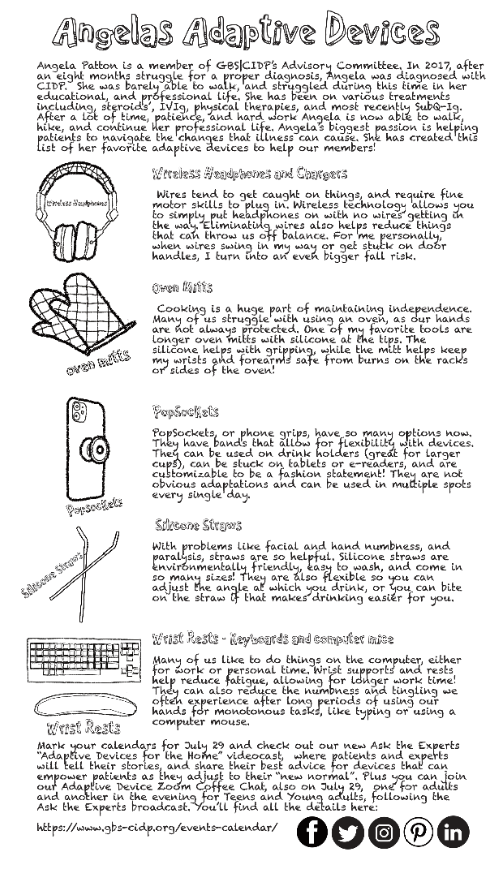Written by Angela Patton

Angela Patton is a member of GBS|CIDP’s Advisory Committee. In 2017, after an eight months struggle for a proper diagnosis, Angela was diagnosed with CIDP. Here is Angela’s story…
I was barely able to walk, and struggled during this time in my educational, and professional life. I have been on various treatments including, steroids’, IVIg, physical therapies, and most recently SubQ-Ig. After a lot of time, patience, and hard work I am now able to walk, hike, and continue my professional life. My biggest passion is helping patients to navigate the changes that illness can cause. I have created this list of my favorite adaptive devices to help our members!
1. PopSockets
PopSockets, or phone grips, have so many options now. They have bands that allow for flexibility with devices. They can be used on drink holders (great for larger cups), can be stuck on tablets or e-readers, and are customizable to be a fashion statement! They are not obvious adaptations and can be used in multiple spots every single day.
2. Silicone Straws
With problems like facial and hand numbness, and paralysis, straws are so helpful. Silicone straws are environmentally friendly, easy to wash, and come in so many sizes! They are also flexible so you can adjust the angle at which you drink, or you can bite on the straw if that makes drinking easier for you.
3. Wireless Headphones and Chargers
Wires tend to get caught on things, and require fine motor skills to plug in. Wireless technology allows you to simply put headphones on with no wires getting in the way. Eliminating wires also helps reduce things that can throw us off balance. For me personally, when wires swing in my way or get stuck on door handles, I turn into an even bigger fall risk.
4. Oven Mitts
Cooking is a huge part of maintaining independence. Many of us struggle with using an oven, as our hands are not always protected. One of my favorite tools are longer oven mitts with silicone at the tips. The silicone helps with gripping, while the mitt helps keep my wrists and forearms safe from burns on the racks or sides of the oven!
5. Wrist Rests – keyboards and computer mice
Many of us like to do things on the computer, either for work or personal time. Wrist supports and rests help reduce fatigue, allowing for longer work time! They can also reduce the numbness and tingling we often experience after long periods of using our hands for monotonous tasks, like typing or using a computer mouse.
Mark your calendars for July 29 and check out our new Ask the Experts “Adaptive Devices for the Home” videocast, where patients and experts will tell their stories, and share their best advice for devices that can empower patients as they adjust to their “new normal”. Plus you can join our Adaptive Device Zoom Hangout for Teens & Young Adults, also on July 29, You’ll find all the details here: https://www.gbs-cidp.org/events-calendar/
